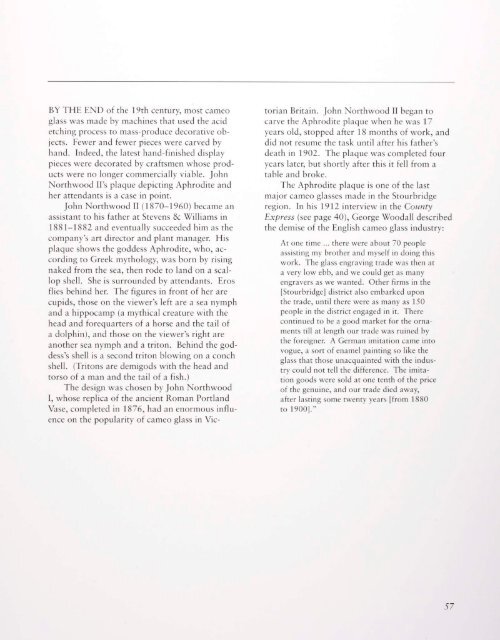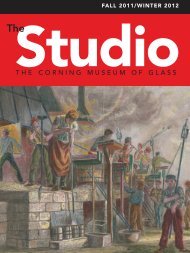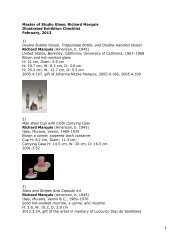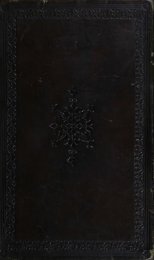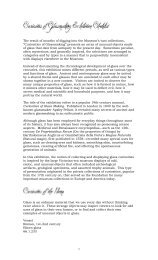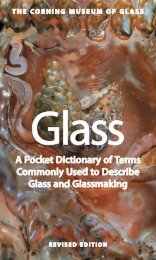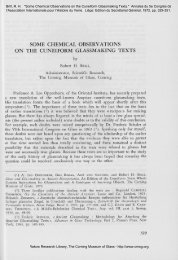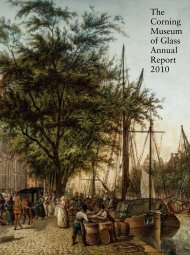english cameo glass in the corning museum of glass
english cameo glass in the corning museum of glass
english cameo glass in the corning museum of glass
Create successful ePaper yourself
Turn your PDF publications into a flip-book with our unique Google optimized e-Paper software.
BY THE END <strong>of</strong> <strong>the</strong> 19th century, most <strong>cameo</strong><br />
<strong>glass</strong> was made by mach<strong>in</strong>es that used <strong>the</strong> acid<br />
etch<strong>in</strong>g process to mass-produce decorative objects.<br />
Fewer and fewer pieces were carved by<br />
hand. Indeed, <strong>the</strong> latest hand-f<strong>in</strong>ished display<br />
pieces were decorated by craftsmen whose products<br />
were no longer commercially viable. John<br />
Northwood II's plaque depict<strong>in</strong>g Aphrodite and<br />
her attendants is a case <strong>in</strong> po<strong>in</strong>t.<br />
John Northwood II (1870-1960) became an<br />
assistant to his fa<strong>the</strong>r at Stevens & Williams <strong>in</strong><br />
1881-1882 and eventually succeeded him as <strong>the</strong><br />
company's art director and plant manager. His<br />
plaque shows <strong>the</strong> goddess Aphrodite, who, accord<strong>in</strong>g<br />
to Greek mythology, was born by ris<strong>in</strong>g<br />
naked from <strong>the</strong> sea, <strong>the</strong>n rode to land on a scallop<br />
shell. She is surrounded by attendants. Eros<br />
flies beh<strong>in</strong>d her. The figures <strong>in</strong> front <strong>of</strong> her are<br />
cupids, those on <strong>the</strong> viewer's left are a sea nymph<br />
and a hippocamp (a mythical creature with <strong>the</strong><br />
head and forequarters <strong>of</strong> a horse and <strong>the</strong> tail <strong>of</strong><br />
a dolph<strong>in</strong>), and those on <strong>the</strong> viewer's right are<br />
ano<strong>the</strong>r sea nymph and a triton. Beh<strong>in</strong>d <strong>the</strong> goddess's<br />
shell is a second triton blow<strong>in</strong>g on a conch<br />
shell. (Tritons are demigods with <strong>the</strong> head and<br />
torso <strong>of</strong> a man and <strong>the</strong> tail <strong>of</strong> a fish.)<br />
The design was chosen by John Northwood<br />
I, whose replica <strong>of</strong> <strong>the</strong> ancient Roman Portland<br />
Vase, completed <strong>in</strong> 1876, had an enormous <strong>in</strong>fluence<br />
on <strong>the</strong> popularity <strong>of</strong> <strong>cameo</strong> <strong>glass</strong> <strong>in</strong> Vic-<br />
torian Brita<strong>in</strong>. John Northwood II began to<br />
carve <strong>the</strong> Aphrodite plaque when he was 17<br />
years old, stopped after 18 months <strong>of</strong> work, and<br />
did not resume <strong>the</strong> task until after his fa<strong>the</strong>r's<br />
death <strong>in</strong> 1902. The plaque was completed four<br />
years later, but shortly after this it fell from a<br />
table and broke.<br />
The Aphrodite plaque is one <strong>of</strong> <strong>the</strong> last<br />
major <strong>cameo</strong> <strong>glass</strong>es made <strong>in</strong> <strong>the</strong> Stourbridge<br />
region. In his 1912 <strong>in</strong>terview <strong>in</strong> <strong>the</strong> County<br />
Express (see page 40), George Woodall described<br />
<strong>the</strong> demise <strong>of</strong> <strong>the</strong> English <strong>cameo</strong> <strong>glass</strong> <strong>in</strong>dustry:<br />
At one time ... <strong>the</strong>re were about 70 people<br />
assist<strong>in</strong>g my bro<strong>the</strong>r and myself <strong>in</strong> do<strong>in</strong>g this<br />
work. The <strong>glass</strong> engrav<strong>in</strong>g trade was <strong>the</strong>n at<br />
a very low ebb, and we could get as many<br />
engravers as we wanted. O<strong>the</strong>r firms <strong>in</strong> <strong>the</strong><br />
[Stourbridge] district also embarked upon<br />
<strong>the</strong> trade, until <strong>the</strong>re were as many as 150<br />
people <strong>in</strong> <strong>the</strong> district engaged <strong>in</strong> it. There<br />
cont<strong>in</strong>ued to be a good market for <strong>the</strong> ornaments<br />
till at length our trade was ru<strong>in</strong>ed by<br />
<strong>the</strong> foreigner. A German imitation came <strong>in</strong>to<br />
vogue, a sort <strong>of</strong> enamel pa<strong>in</strong>t<strong>in</strong>g so like <strong>the</strong><br />
<strong>glass</strong> that those unacqua<strong>in</strong>ted with <strong>the</strong> <strong>in</strong>dustry<br />
could not tell <strong>the</strong> difference. The imitation<br />
goods were sold at one tenth <strong>of</strong> <strong>the</strong> price<br />
<strong>of</strong> <strong>the</strong> genu<strong>in</strong>e, and our trade died away,<br />
after last<strong>in</strong>g some twenty years [from 1880<br />
to 1900]."


